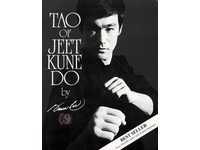I have been toying with the idea of writing books’ reviews for a long time. Have an extensive library of martial arts and eastern philosophies books that cover a broad range of subjects. I hope that what I am going to write about each of them will be enough to inspire some readers to read them, as well as writing some comments about what they think.
When reading a martial art book it is important to have a clear idea of what the main goal for the reading the book is: in my case I never intended to learn a martial art or a style but more to understand the main concepts and philosophy behind it.
The book

Many of us consider Bruce Lee a legend that left a great legacy and inspired entire generations to start and keep training martial arts. For me this is a precious book that I keep handy and go back to read on a regular basis. It is obviously not a novel with a story but more a collection of notes and ideas: small paragraphs and some time single sentenced that describe a strong and deep concept and make you think for a long time. Although the cover sheet states “Tao of Jeet Kune Do – by Bruce Lee” the book was put together by Gilbert L. Johnson and Linda Lee (Bruce Lee’s widow) based on Lee’s original notes.
Description
I see this book as a journal for Bruce Lee himself when he was thinking and refining the concepts behind JKD and how he felt this should have developed. Tao has a strong meaning and multiple interpretations: it is written in Chinese with the same character that is used to write Do in Japanese and it has the same meaning: The Way. This is to describe an approach that is not meant to teach a strict methodology to do this or that.
Each chapter describes a different aspect of the concepts behind JKD: Preliminaries, Qualities, Tools, Preparations, Mobility, Attack, Circle with Circumference and It’s Just a Name. In some parts of the book entire pages are full of hand written notes from Lee himself, in other cases there are drawing that are probably copied by other books at the time: I say this because the drawing style is consistent for some of the simple stylized pictures where an entire person or a limb is represented with a few lines.
JKD maintains and improves many aspects of Wing Chun that is the first martial art that Lee ever practiced when he was still in Hong Kong. Bruce Lee probably wanted to improve what he considered the weak aspects of Wing Chun but, instead of simply adding the missing techniques, he saw an opportunity for a much greater picture, not limited by traditions, cultures, styles or country boundaries. He wanted to define a new concept that many different people, with different backgrounds, could embrace and grow with it.
What I like of this book
Apart from the definitions of this and that technique Lee explores numerous details of the mental aspect of training: what you should think, the attitude you should have and how each of these should be prepared. While he was against rehearsed techniques and combinations because fighting should spark naturally, from the martial artist experience and based on the opponents moves, he covers in details how each aspect of training should be practiced. Considering that disciplines like coaching and motivation, the knowledge of sport science and sport psychology were hardly available at the time Lee was surely a great precursor of these concepts. I also find fascinating the amount of wisdom contained in this book, considering that Lee was in his late twenties when he wrote most of the notes.
Conclusions
I would suggest reading this book to anybody that is interested in martial arts, from beginners to top ranked black belts. Don’t expect to learn JKD by reading it but be prepared to a bit of thinking because each chapter will add some wisdom to your knowledge of martial arts.
If you are interesting in buying this book, or other interesting ones, please have a look at our book store that contain a little collection of the books I read so far.

Yes, this book grants us a brief glimpse into the mind of a martial arts genius! This book is not prescriptive, nor should it be. It provides lenses through which we can improve our own way of perceiving the martial arts.
Nice review!
I think that the thoughtful martial artist would be better served by the original source material, rather than the decontextualized fragments quoted (largely without attribution) in Tao of JKD.
The Tao of Jeet Kune Do is a book that represents the philosophies and life disciplines that made Lee the foremost martial artist of his generation.